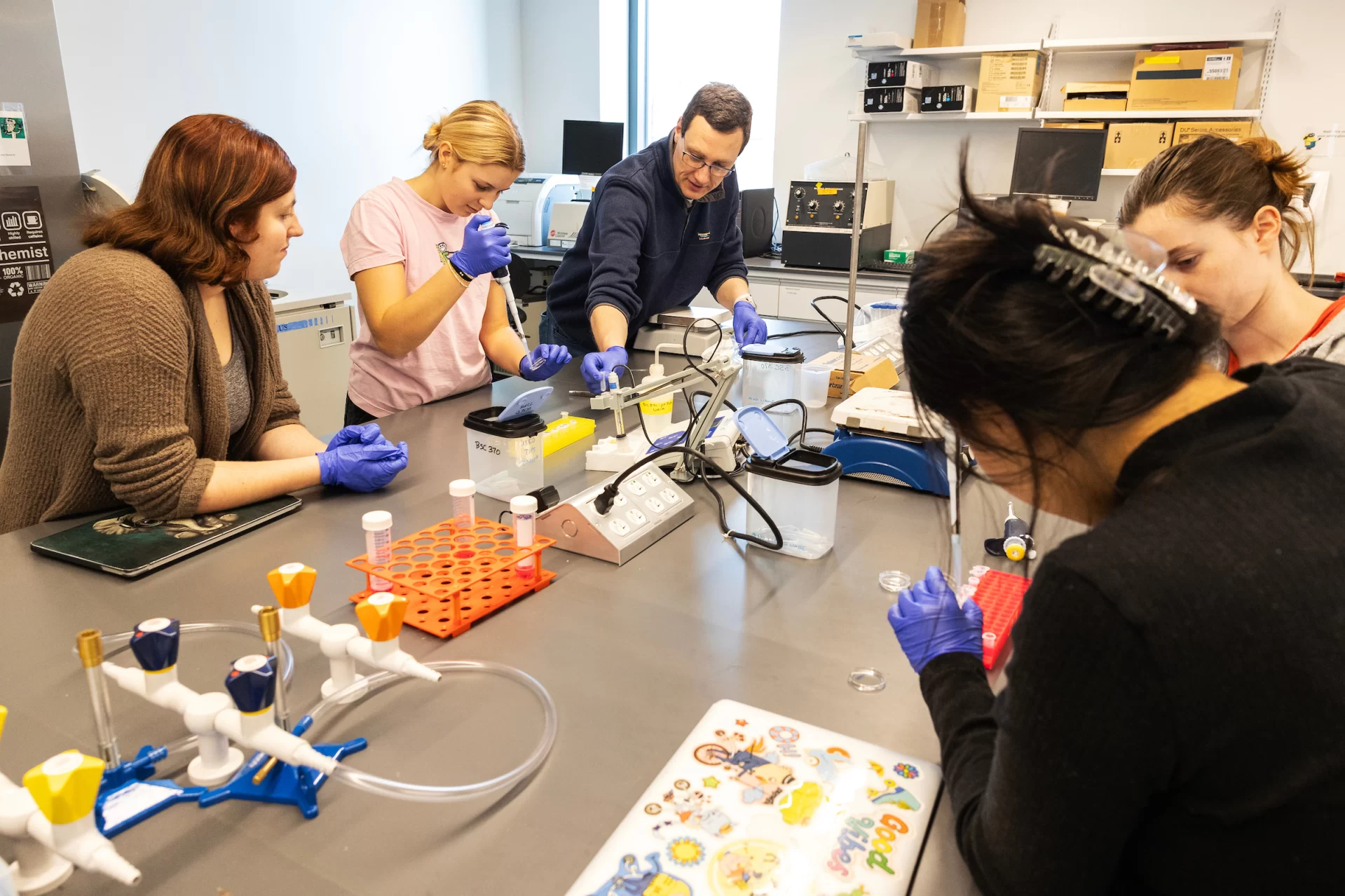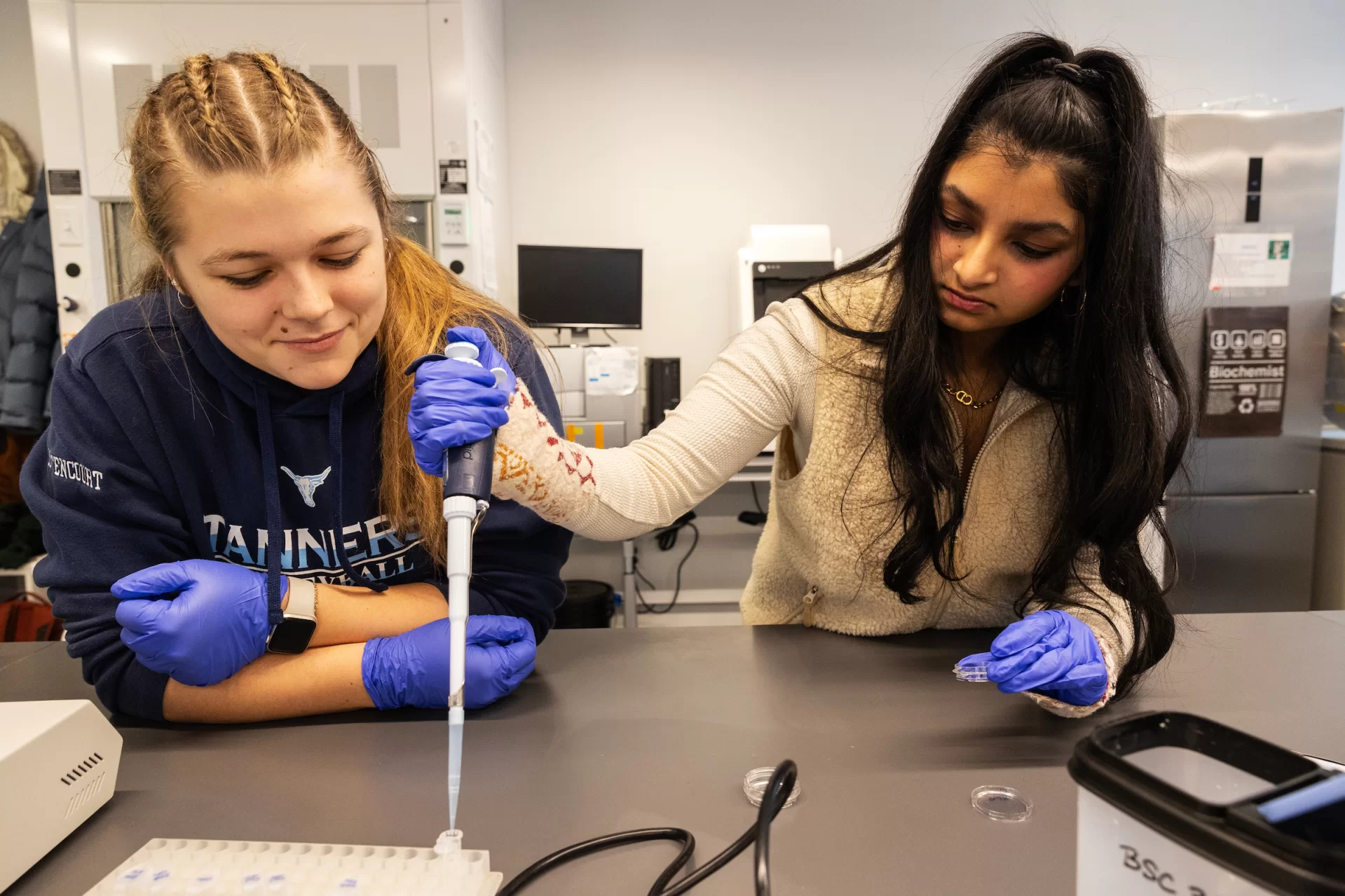
Often, scientists who conduct cutting-edge research are racing elbow-to-elbow against thousands of other researchers to publish their findings first. But when it comes to the research being conducted by Martin Kruse, recently funded with a $415,000 grant from the National Institutes of Health, the Bates associate professor of biology and neuroscience might be in a race by himself.
Kruse will use the NIH grant to study IRBIT, an important but not fully understood protein found in our cells, which might play a critical role in several neurological conditions, such as epilepsy and Alzheimer’s disease. (The letters in protein names, like IRBIT, are not acronyms, per se, but instead convey the protein’s function, structure, or the process they are involved in.)
What is exciting for Kruse is that the protein IRBIT has been “dramatically understudied” up until now, he said. There are only a few dozen scholarly papers describing the protein. So Kruse could be the first to answer basic fundamental questions about IRBIT such as: How does it work in the cell? Where is it in the cell? And under what conditions does the protein restrict calcium signals?

Finding the answers to these basic questions, Kruse said, would be a considerable contribution to science.
“We are luckily not to be in a situation where we are competing with hundreds to thousands of other research groups which are all doing similar things, and it would therefore be like a foot race to be the first one to publish findings,” Kruse said. “I’m hoping we have the opportunity to be some of the first to provide knowledge on how this protein really works.”
With the release of too much calcium in our cells, “certain parts in our brain, for instance, become more active, other parts might become less active. And this has triggered tremendous interest in many neuroscientists.”
Martin Kruse
Human cells typically maintain low calcium ion concentrations. Then, under certain conditions, a signal releases “a little bit of that calcium from storage into the rest of the cell.”
But too much calcium being released can be incredibly harmful. The research Kruse is pursuing with Bates students could bear out the theory that a lack of IRBIT in cells leads to a harmful increase in calcium signals.
With the release of too much calcium, “certain parts in our brain, for instance, become more active, other parts might become less active,” Kruse said. “So it changes our behavior, it changes the way we might be thinking,” and possibly plays a role in neurological disorders like epilepsy or Alzheimer’s disease. “And this has triggered tremendous interest in many neuroscientists.”
Kruse’s research on IRBIT has an important connection to another area of his work. For about 15 years, he has studied a certain type of lipid known as phosphoinositides, which were once thought to be bit players in cell functioning but are now known to regulate the flow of molecular signals, like a cellular traffic cop.

Under certain conditions, phosphoinositides get destroyed, and that can lead to an unexpected release of calcium ions. Kruse and his student researchers will investigate the connection between phosphoinositides, the activation of IRBIT, and the release of calcium ions.
“We think, and there’s also some preliminary evidence for, that alterations in the levels of IRBIT in a cell also influence the metabolism of the cell for the lipids that activate these calcium signals.”
Kruse got involved with this research in 2010 during a postdoctoral fellowship at University of Washington in Seattle. He brought that research to Bates in 2017 and has since acquired preliminary data with the help of students — all of which helped land the NIH grant.
In the past year, using a kidney cell line known as HEK293, which has certain properties that make it a great model system for research, Kruse and his students ran tests using the powerful genome-editing technology known as CRISPR-Cas9 (pioneered by Nobel Prize–winning biochemist Jennifer Doudna, recipient of a 2019 Bates honorary degree).
They deleted the IRBIT protein in one cell but not another to see if the cells without the protein IRBIT have larger calcium signals than the cells with the protein.
“We compared the genetically modified cell with the cells with IRBIT. It appears it does make a difference for the cells if they have IRBIT or not. The protein indeed seems to be a regulator of these calcium signals,” Kruse said. “If the protein is gone, the calcium signals grow bigger and it kind of shows that, in a healthy cell, IRBIT would be restricting the calcium signals.”
The research Kruse is pursuing with Bates students could bear out the theory that a lack of IRBIT activity in cells — and a resulting increase in calcium signals — is a factor in these neurological conditions.
Typically such groundbreaking research is done at research universities with teams of graduate students all working 50 to 70 hours a week. But Kruse is excited to share this rare, golden opportunity with his students.

This year, several senior thesis students are tackling subjects related to Kruse’s research: Sydney Rastkhane of North Haven, Conn., Nick Gonzalez of Chappaqua, N.Y., and Ben Morse of Sunderland, Mass. Rastkhane and Gonzalez will join Kruse in presenting the lab’s research to date at the Biophysical Society’s annual meeting on Feb. 11 in Philadelphia.
Meanwhile, if Kruse’s research sheds new light on the protein, it could one day lead to new treatments for some neurological diseases.
“I think any kind of knowledge that we can acquire about this would help in a clinical setting to come up with better treatments. That would be fantastic,” Kruse said.
Research reported in this publication was supported by the National Institute Of General Medical Sciences of the National Institutes of Health under Award Number R15GM150377. The content is solely the responsibility of the authors and does not necessarily represent the official views of the National Institutes of Health.



